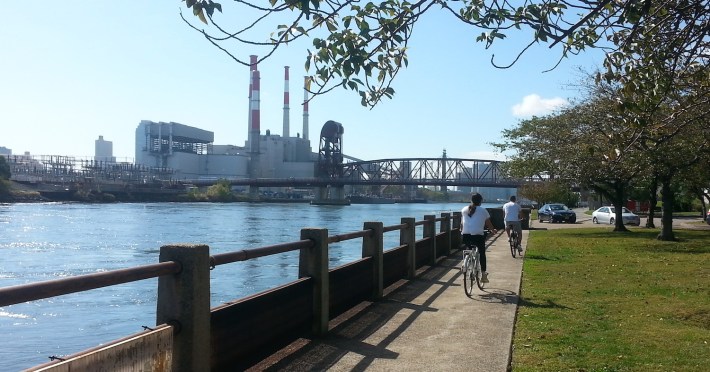
By now, it seems almost all of Roosevelt Island's 12,300 residents have heard about Anna Maria Moström, the cyclist left brain dead last week after a bus driver struck her while failing to yield during a turn. The quiet island, shaped into a mostly residential neighborhood by a 1970s redevelopment effort, has long fostered the feeling of an urban village. Despite its natural advantages and a decent number of bike riders, cycling has never really boomed on Roosevelt Island. For the past year, a joint effort from Bike New York and the state authority overseeing the island has sought to change that. Even before last week's crash rattled islanders, many residents here didn't feel comfortable on two wheels.
Two miles long and no wider than the distance between two Manhattan avenues, Roosevelt Island today is connected to the rest of New York by an aerial tram, a subway stop, and a bridge to Queens (the Queensboro Bridge passes over the island but does not connect to it). Because it is effectively a big cul-de-sac, traffic volumes are low and drivers travel slowly. While there are more cars than envisioned in the 1970s master plan, which called for a mostly car-free island, Roosevelt Island remains a contrast with the rest of the car-clogged city. The speed limit on the island is just 15 mph.
Despite these advantages, bicycling has struggled to blossom under the Roosevelt Island Operating Corporation, the state body overseeing the neighborhood's day-to-day services. But in recent years, RIOC has become more interested in bicycling. A few years ago, the corporation inventoried bike racks on the island, and despite occasional missteps like an overzealous program that resulted in wholesale removal of parked bikes, continues to show interest. "This is a family-friendly place, and we have a lot of cyclists," said Erica Spencer-El, a community relations specialist at RIOC.
RIOC hosted a temporary demonstration from bike-share provider B-Cycle in 2010, before the advent of Citi Bike. It was popular, but RIOC's board has put future discussion of bike-share on hold. "We were putting the carriage before the horse. Our infrastructure is not ready," Spencer-El said. She pointed around the island's streets, which have a hodge-podge of signs and markings. Some crosswalks include stop signs; others only tell drivers and cyclists to yield. There is no consistent street design.
That's where Bike New York comes in. "The signage here is a little bit confusing," said Rich Conroy, the group's education programs director. "Either it's a hard stop or it's not."

While Bike New York will ultimately tackle some of these issues with recommendations for RIOC, it's starting with what it does best: Offering free bike education classes. Bike New York started working on the island last November, first at the Sportspark recreation center, then expanding to a storage container parked beneath the Motorgate parking garage. The group stores 70 bikes in the two locations for its classes. Bike New York is working with The Child School to integrate bicycling into its curriculum with a six-week program, and hopes to work with PS/IS 217 next.
Caitlin Goodspeed was hired by Bike New York a year ago and is the group's only staffer devoted to a specific neighborhood, spending all of her time focused on Roosevelt Island. Goosdpeed has started counting cyclists at key locations like the Roosevelt Island Bridge, the tram, and the subway station. She's created a listserv of nearly 350 island residents interested in cycling, and has forged relationships with residents, schools, RIOC staff, and elected officials like Council Member Ben Kallos.
Tuesday morning, staff from Bike New York and RIOC held a walking meeting to assess on-the-ground changes that could make cycling safer and easier. While the meeting had been scheduled before Moström's crash, it was opened to the press in the wake of the collision. Throughout the walk, RIOC staff refused to talk about the case, citing NYPD's ongoing investigation. RIOC Director of Operations Cy Opperman oversees "red bus" drivers, one of whom struck Moström last week. Opperman said he has not been in touch with NYPD about its investigation and would not say whether or not the driver who struck Moström is still behind the wheel this week. "I have no comment," he said.
Opperman said all RIOC drivers receive DMV-approved defensive driving classes. For "red bus" drivers, he administers annual road tests and observational rides, but they do not go to the safety training classes the MTA requires for its operators. (Opperman worked at the MTA for 32 years before starting at RIOC four years ago.)
During the walking tour, Opperman spotted a woman cycling with her two children in a cargo carrier. To avoid cars, she pedaled onto the sidewalk. Opperman grumbled about the bad behavior.
I interviewed the woman later when she circled by a second time. "There's not room enough for biking on the street. I'm not supposed to be on the sidewalk," said Birgitte Noël, a Roosevelt Island resident originally from Denmark who was bicycling with her son and nephew. "I take him to daycare and grocery shopping," she said of her son. Noël had heard about Moström's crash, because the two live in the same building and have a mutual friend. While Noël takes her bike off-island, she doesn't take her son on those trips, citing the steep ramp to the bridge and busy city streets as barriers.
The bridge is the city's responsibility, and improvements may be in the works. As part of its Western Queens transportation study, the Department of City Planning last week suggested a two-way protected bike path on the Roosevelt Island Bridge with easier, more direct connections to greenways on the island. DCP also recommended a protected bikeway along 36th Avenue from the bridge to the subway.
Another possible improvement: The bridge has open metal grates across its central span, creating dangerous grooves for cyclists. During the walk yesterday, Bike New York's Goodspeed pointed to panels Chicago has installed on its bridges that offer a smoother, safer ride as a potential solution for the Roosevelt Island Bridge.
DCP's draft report recommends a new bike path from the bridge to the Cornell Technion campus, under construction on the island's southern end. I asked Opperman if RIOC has been in discussions with the city or the university about planning for transportation to the new campus, and he shook his head. The project is beyond RIOC's boundaries, he said.

While the Cornell Technion campus is years away from completion, there are more immediate changes that could improve cycling on the island that are under RIOC's direct control. In 2010, the corporation installed sensors in parking spots to monitor occupancy. The project converted a section of West Road from two-way to one-way flow and added 16 new parking spaces, Spencer-El said. Now, many cyclists on the island go the wrong way on West Road, instead of detouring to the busier and less direct Main Street.
The street has "do not enter signs" and Opperman added "bikes prohibited" signs to reinforce the rules against wrong-way riding. Conroy suggested signage that directed cyclists instead of admonishing them. "I'm not taking the sign down. I had enough trouble putting it up there," Opperman said. "They just go the wrong way. They're not wearing helmets." Later, Opperman and Spencer-El both said they thought the city ought to have a mandatory helmet law for adult cyclists.
Spencer-El said the parking sensor pilot on West Road, which covered only 29 spaces, had run its course. Perhaps a two-way route for cyclists was important, she said, and the parking could be removed. "Some parts of the island are fine for parking. Other parts, we could do without it," Spencer-El said.
Given the island's low traffic volumes and slow speeds, I asked if RIOC or Bike New York were considering shared space, which removes signs, striping, and curbs to mix pedestrians, cyclists, and motorists in low-speed environments. NYC DOT is studying the concept for three blocks in Downtown Brooklyn. Oppermann favored separating road users into separate zones. A lifelong Upper East Side resident, he looked to First Avenue as a model. "Everybody's in their own lane," he said. "It's beautiful."
While a comprehensive street redesign is unlikely anytime soon, Bike New York will start to make recommendations to RIOC about signage, road markings, and other changes to the island's streets. Spencer-El said RIOC has yet to determine if it will produce a master plan for bicycling on the island or continue its relationship with Bike New York on a more informal basis.
"We'll make some recommendations," said Bike New York's Conroy. "All you can do is make the suggestion and see what someone else is going to do."





